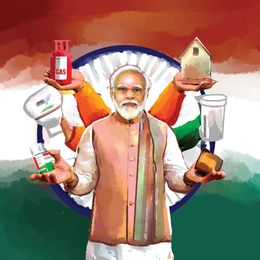The headline is the title of a turn-of-the-century Hollywood fantasy starring Mel Gibson and Helen Hunt. The film was a box-office hit, but its 2019 loose remake, What Men Want, flopped. Who wants to know what men want?
So what do women want? Men of my generation, when we wanted to please our wives on their birthdays or our anniversaries, bought them a new mixie, a refrigerator, a washing machine, a toaster, some comfy bed linen or fancy table linen—depending on the size of our pay cheques. Those were the kind of stuff, we thought, would ease the wives’ chores, give them more time to spend with us and children, make our homes brighter, and bring cheer to all at home. Called MCPs today, we spent our youths in an age when utility weighed more in our minds than the lure of luxury.
Men of my son’s or son-in-law’s generation are more focused. They buy chiffons, silks, handbags, shoes, dresses or diamonds for their wives—depending on their credit limits. The kind of things that are of her personal use, yet the possession of which would make her feel enriched, empowered and proud.
To me, watching the elections from Delhi, Narendra Modi appeared like a man of my generation, the kind who wooed our women with goodies that we too wanted in our homes. Now, after a whirlwind tour of south Bengal, Mamata Banerjee appeared to me like a new-gen husband—one who woos the woman with what she covets.
Look at what Modi is claiming to have gifted women in 10 years—his manifesto, aka guarantee card, lists free cooking gas to 10 crore-plus poor women, toilets to 11 crore-plus women, vaccination to six crore-plus mothers and children, and more.
What’s on offer? Help for three crore women to become lakhpati didis, skill up the women self-help groups, seats for a few thousand in Parliament, state assemblies and panchayats, and so on. Pretty heavy stuff, but pretty useful, too, to society at large. Much like the gifts that my generation gave our wives—useful to all at home.
And Mamata? Calling her regime Maa-Mati-Manush sarkar, she is putting money directly into women’s purses. Her Lakshmir Bhandar scheme puts Rs1,000 each into the accounts of two crore women—Rs1,200 if she is a dalit or adivasi. Close to 12 lakh old women are getting pension; 20 lakh women get widow pension. And she is offering Rs1,000 a year to every high school girl, and a one-time gift of Rs25,000 when she joins a college or a skills class, and more when she goes for her master’s.
What’s the difference? One is paternalistic and patronising; the giver thinks he knows what is good for her and gives. The other is entrusting and empowering. The giver trusts her with the money and empowers her to do what she likes with it. In this workaday world, nothing empowers a person more than money in hand which she can spend as she wills.
Not that the BJP doesn’t know this. It was a similar Ladli Behena scheme that returned the party to power in the last Madhya Pradesh polls, just as the Congress had wooed the Kannadiga women with a Gruha Lakshmi scheme. However, unlike these schemes which target the deprived, Mamata’s ones are for all—rich, poor, privileged or deprived.
Will these win votes? Can’t say, but women throng her meetings outnumbering men three to two. She plays to their gallery, singing and dancing with them.
The Durga imagery is not to be missed. Mamata radiates energy. She doesn’t stand and deliver. With a cordless mic in hand, she sweeps the stage at a brisk pace, much like a new-age motivation speaker.
Or, shall we say, Durga at her war dance?
prasannan@theweek.in


